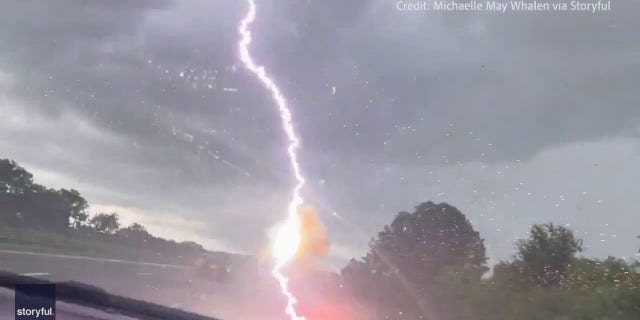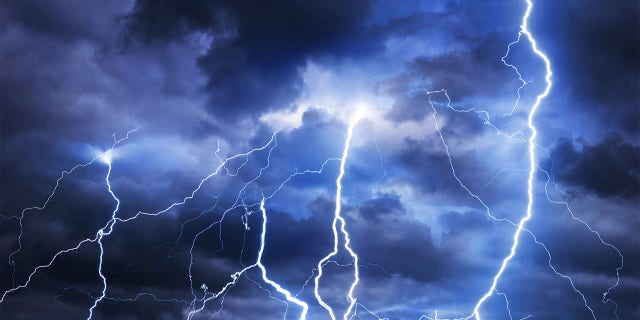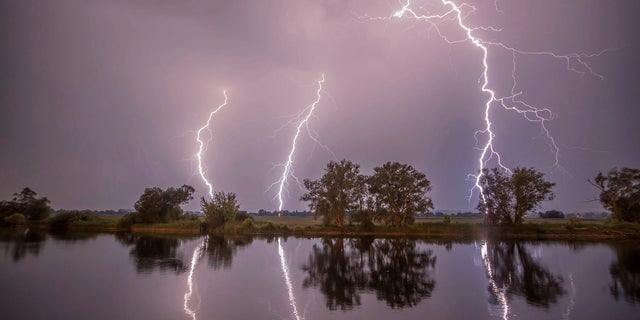[ad_1]
NEWYou can now listen to Fox News articles!
Lightning strikes took the lives of three people recently outside the White House in Washington, D.C.
James Mueller and Donna Mueller of Janesville, Wisconsin, both in their 70s, succumbed to their injuries following the strike at Lafayette Park on Thursday night, a spokesperson from DC Metro Police told Fox News Digital on Friday.
The third victim was 29-year-old Brooks Lambertson, a vice president for City National Bank from Los Angeles, California. A fourth person was also injured and is in critical condition.
People are advised to take smart precautions against lightning strikes before, during and after storms to protect themselves.
LIGHTNING STRIKE SAFETY: WHAT TO DO, HOW TO KEEP YOURSELF SAFE
“We are saddened by the tragic loss of life after the lightning strike in Lafayette Park,” White House press secretary Karine Jean-Pierre said in a statement late last week. “Our hearts are with the families who lost loved ones.”
Also, a 22-year-old young man from Boston died of cardiac arrest after he was struck by lightning in Wyoming on August 2 while backpacking during an expedition in Bridger-Teton National Forest, Fox 25 reported this weekend.
Lightning can strike anywhere on Earth, the Centers for Disease Control and Prevention (CDC) makes clear on its website.

Video shows the moment lightning strikes a truck in Tampa, Florida, in early July 2022.
(Michaelle May Whalen via Storyful)
“There are about 6,000 lightning strikes every minute, which is more than 8 million strikes every day,” the CDC says.
“You can protect yourself and your loved ones if you know what to do when you see lightning or when you hear thunder as a warning.”
“From 2006 through 2021, lightning caused an average of 28 deaths per year in the United States.”
It adds, “The risk of being struck by lightning is low, but the consequences of lightning strike injuries are serious.”
“From 2006 through 2021, lightning caused an average of 28 deaths per year in the United States.”
‘I was taking clothes out of the dryer’
Linda Venuto-Deal of Burlington County, New Jersey, came close to suffering a serious or fatal injury from lightning — and described her frightening experience to Fox News Digital in a phone interview this weekend.
She was not outside at the time — she was inside her house, in the basement, when it happened. The CDC says that about a third of lightning injuries occur indoors.
A bolt of lightning hit the ground pipe of her house while she was inside, she said, on Aug. 23, 1993.
LIGHTNING STRIKES RAM PICKUP IN FLORIDA — HERE’S WHY THE PASSENGERS SURVIVED
She recalls the precise date of the strike that sent her to the emergency room and left scars because she took detailed notes about what happened.
“I was doing the laundry,” she said. The family had just returned from a trip to an amusement park.
She had two loads of wash in progress, she said.

Linda Venuto-Deal of New Jersey described her encounter with lightning when she was inside her home doing the laundry.
“And I was taking clothes out of the dryer and was reaching in, grabbing my daughter’s lime-green T-shirt,” said Venuto-Deal.
“I was taking out the clothes when the lightning hit at that moment.”
She said the lightning — after hitting a ground pipe outside her house — traveled through to her basement and arced into the dryer.
“It went into my pinkie finger and my ring finger on my left hand,” she said.
“Pretty amazing, I know,” she said, recounting the experience.
She circled the burn mark on the floor of her basement so that she would know exactly where the lightning hit.
She said the lightning then “went up my arm, into my face, down my body and left leg — and out my foot.”
“It hit the floor like a giant checkmark sign,” she said, describing the sound of the lightning bolt that she recalls to this day, “and then it went into the wall. And that’s when it dissipated,” she added.
SERIES OF LIGHTNING STRIKES ACROSS INDIA KILL 20 PEOPLE
She circled the burn mark on the floor of her basement so that she would know exactly where it hit, she said.
“I had it there for years and years until I finally had the basement painted,” she said.
After all these years, “I still have the scar on my foot, too,” she said.
The weirdest thing is that “I heard this faraway screaming.”
She described the strike as dry lightning — it wasn’t raining outside at the time that it happened.
The weirdest thing for her is that “I heard this faraway screaming,” she said.
She immediately thought about her daughter who was upstairs in the kitchen — and wondered frantically if she was OK.
“But it was actually my voice,” she said, that was screaming. “It was so disconnected from me that it sounded like it was coming from outside my house.”

Thunder, lightning and rain during a summer storm. Linda Venuto-Deal said she wasn’t wearing shoes when she suffered a lightning strike.
(iStock)
She said the lightning that day killed one of her trees outside — and “it blew out the appliances in the house. It cracked all the archways in my house, too.”
She added, “The only reason the doctor said it didn’t kill me was because I had no shoes on at the time — and it had an outlet.”
“I was barefoot and it came out my foot. It didn’t stay inside my body.”
“I was numb and my two fingers were kind of purple for a while.”
She got herself to the hospital — “I went to the E.R., and it was pouring rain by then,” she said, describing that memorable evening.
“I was numb and my two fingers were kind of purple for a while,” she said.
“And the side of my face was numb, on that left side.”
HOUSE IN NORTH CAROLINA SET ABLAZE BY LIGHTNING STRIKES: REPORTS
She said she also had a “tingly feeling” in her face and in her arm, which “lasted a few days.”
She said that in the hospital, doctors checked her out fully; her blood pressure and her temperature were taken, she said. She was not kept overnight in the hospital; she was sent home later that day, she said.
‘Developed high blood pressure’
“The funny thing is,” added the New Jersey resident, “that right after that, I developed high blood pressure, at the age of 40.”
She said of that development: “I always thought, ‘I’m only 40 years old.'”
She said she’s been treated for high blood pressure ever since.
“I’ve survived darn near everything.”
“Also interesting is that I developed breast cancer on that side, five years later,” she said. “I don’t have any science to back me up. Only what I think.”
She added that her hair stood on end as a result of the lightning strike — and she had “amazingly long hair” at that point, down to her legs, she said.
The hair on her arms also “prickled right up,” she said.

Lightning lights up the sky over Lower Manhattan as a bolt strikes One World Trade Center on Aug. 22, 2017, as seen from Hoboken, New Jersey.
(Fox News/Gary Hershorn)
That was her one and only experience with lightning — “Thank goodness,” she said.
“I’ve survived darn near everything,” she added.
There is “no safe place outside” when thunderstorms are in your area, according to the National Weather Service.
Oren N. Gottfried, M.D., professor of neurosurgery at Duke Medical School in the Dept. of Neurosurgery and director of the Neurosciences Clinical Specialties Unit at Duke University School of Medicine, told Fox News Digital in an email on Sunday, “When someone is struck by lightning, they require prompt medical assistance. If more than one person is injured, treat or attend to any unconscious victims first.”
Dr. Gottfried added, “The most significant injuries are cardiac arrest or severe neurological injury.”
He also said, “Some people struck by lightning may appear dead, with no pulse or recognizable breathing, but will still have a reasonable chance for survival.”
“It is important to recognize that people may initially look much sicker than they are and immediate, aggressive care greatly improves survival rates.”

“If the victim is unconscious and not breathing well or at all, or has no pulse, call 911 and start standard CPR right away,” said Dr. Oren Gottfried of Duke University School of Medicine in Durham, North Carolina.
(iStock)
Dr. Gottfried noted further, “It is safe to touch and offer care to the person, as the body does not keep a charge.”
“If the victim is unconscious and not breathing well or at all, or has no pulse, call 911 and start standard CPR right away. It is necessary to continue CPR for long periods for an otherwise healthy person struck by lightning, as many victims can survive.”
Dr. Marc Siegel, a physician and professor of medicine at the NYU Langone Medical Center in New York City and a Fox News contributor, told Fox News Digital that according to the CDC, the states of Florida, Texas, Georgia, Missouri, New Jersey and Pennsylvania have had the most lightning strikes.
After a lightning strike, “thermal burns, breathing problems, confusion, irregular heart beat and cardiac arrest can all occur.”
Florida has had 2,000 over the past 50 years, he said.
After a lightning strike, “thermal burns, breathing problems, confusion, irregular heart beat and cardiac arrest can all occur,” said Dr. Siegel.
He also said that “personality changes, seizures, dizziness, muscle pain, loss of consciousness and coma can all occur.”
LIGHTNING STRIKE IN CALIFORNIA KILLS WOMAN, HER TWO DOGS
It’s “necessary to treat the burns, sometimes with surgical debridement,” he said.
Also, “immediate immobilization and CPR when needed saves lives,” he added.
Here are some important additional details about lightning — including safety tips.
What are the odds of being struck by lightning?
The chance of an individual in the U.S. being struck by lightning during a given year is one in 1.2 million, according to the National Weather Service (NWS).
The odds of being struck in your lifetime (estimated to be 80 years) are 1 in 15,300.
Is there any safe place outside if lightning strikes?
There is “no safe place outside” when thunderstorms are in your area, according to the NWS.
“If you hear thunder, you are likely within striking distance of the storm,” says the NWS.

Two young women were seriously injured recently after lightning struck them while they were taking selfies in Western Germany.
(AP)
“Just remember: ‘When Thunder Roars, Go Indoors.’ Too many people wait far too long to get to a safe place when thunderstorms approach.”
“Unfortunately,” the NWS adds, “these delayed actions lead to many of the lightning deaths and injuries in the United States.”
What if you’re outside and can’t get to safety?
You can “slightly lessen” the threat of being struck by lightning, the NWS says — but it adds an emphatic warning: “Don’t kid yourself — you are NOT safe outside.”
If visiting a new area, make sure to know the weather patterns there, it says. “For example, in mountainous areas, thunderstorms typically develop in the early afternoon, so plan to hike early in the day and be down the mountain by noon.”
If you are in a group, spread out to avoid the current traveling between group members.
It also says, “Listen to the weather forecast for the outdoor area you plan to visit. The forecast may be very different from the one near your home. If there is a high chance of thunderstorms, stay inside.”
It adds these important safety tips as well, according to its website.
Avoid open fields, the top of a hill or a ridge top.
Stay away from tall, isolated trees or other tall objects. If you are in a forest, stay near a lower stand of trees.
If you are in a group, spread out to avoid the current traveling between group members.
If you are camping in an open area, set up camp in a valley, ravine or other low area. Remember, a tent offers NO protection from lighting.
Stay away from water and wet items, such as ropes, and metal objects, such as fences and poles.
Water and metal do not attract lightning, but they are excellent conductors of electricity. The current from a lightning flash will easily travel for long distances.
How do you protect yourself from lightning when you’re indoors?
“Safe shelters are buildings with electricity and plumbing or metal-topped vehicles with the windows closed,” notes the NWS.
“Picnic shelters, dugouts and small buildings without plumbing or electricity are not safe.”
It notes, “There are three main ways lightning enters structures: a direct strike, through wires or pipes that extend outside the structure or through the ground.”
SELFIES WITHOUT SENSE: PEOPLE KEEP RISKING THEIR LIVES FOR THE ‘PERFECT’ PHOTO
The National Weather Service adds, “Once in a structure, lightning can travel through the electrical, phone, plumbing, and radio/television reception systems. Lightning can also travel through any metal wires or bars in concrete walls or flooring.”
It shares the following tips as well.
Stay off corded phones. You can use cellular or cordless phones.
Don’t touch electrical equipment such as computers, TVs or cords. You can use remote controls safety.

Lightning strikes north of Mackworth Island in Maine, on Sept. 11, 2013.
(AP Photo/Robert F. Bukaty, File)
Avoid plumbing. Do not wash your hands, take a shower or wash dishes.
Stay away from exterior windows and doors that might contain metal components leading from outside your home to the inside.
Stay off balconies and porches. Stay out of open garages or car ports.
COAST GUARD RESCUES 7 AFTER LIGHTNING STRIKES BOAT 100 MILES OFF FLORIDA
Do not lie on concrete floors or lean against concrete walls.
Protect your pets. Dog houses are not safe shelters. Dogs that are chained to trees or on metal runners are particularly vulnerable to lightning strikes.
Do not unplug equipment during a thunderstorm, as there is a risk you could be struck.
Protect your property. Lightning generates electric surges that can damage electronic equipment some distance from the actual strike.
Typical surge protectors will not protect equipment from a lightning strike.
Do not unplug equipment during a thunderstorm, as there is a risk you could be struck.
What if your home is struck by lightning?
If your home is struck by lightning, insurance agents suggest you call 911 to have firefighters check to see if there are any hidden hotspots in walls or attic spaces.
CLICK HERE TO SIGN UP FOR OUR LIFESTYLE NEWSLETTER
After the property has been deemed safe, take photos and detailed notes of the damage and make sure time stamps are on all entries, suggested American Family Insurance, as Fox Weather pointed out.
An insurance agent and adjuster will need this vital information, most likely, during a damage assessment.
CLICK HERE TO GET OUR FOX NEWS APP
Experts also warn that you’ll likely have to pay a deductible before insurance kicks in to cover the entire amount of loss.
Shiv Sudhakar, Greg Norman, Emma Colton and Bradford Betz, as well as Fox Weather, contributed reporting to this article.
[ad_2]